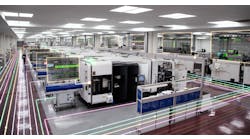In the quest for improved productivity and profitability, shop owners and managers are realizing that implementing lean manufacturing or other process improvement methods requires timely data, and that makes the need to capture timely and useful data from the shop floor critical.
Similarly, implementing any of the accounting, order tracking, dashboard, or other software applications that offer substantial productivity and profitability improvements also requires timely data gathering.
However, there are two significant problems with gathering data.
The first is that it can increase labor costs at a time when reducing labor costs is more important than ever.
The second is that implementing an automated data capture system is often difficult and expensive. Also, a system you implement today may not meet tomorrow’s needs.
It is that last consideration, the ability of a data collection system to meet current and future needs that should be the foremost consideration when planning such a system.
The most common applications that are being implemented in shops today are machine monitoring, work process monitoring and employee time and attendance. There are already a number of software packages available to address each of those functions, but there also are a number of technologies becoming available that take a broader look at work environments and enable shop operators to become more effective in managing the entire work environment.
First and foremost among those emerging technologies is wireless communication.
In the 1990s, the Federal Communication Commission authorized the use of wireless local area networks, and today, it is hard to buy a computer that is not equipped with wireless communication.
Wireless communication is not only a replacement for wired communication, it opens up possibilities beyond the capabilities of hard-wired communication.
Consider the growing use of RFIDs, radio-frequency identification tags or transponders. An RFID tag contains two parts. One part is the integrated circuit that is used to store, process and transmit information; the other part is the antenna that is used to receive or transmit signals.
RFIDs have found widespread use in tracking shipments. In machine shops, they can be used to track and monitor raw materials, tools, completed parts and people. With the right wireless hardware and software, a shop operator can watch the flow of people and materials around the shop.
Doing that in real-time can show where all of his people, pallets of parts and materials are at any given moment, and doing that in historical time lapse can help to identify bottlenecks and wasted movements that otherwise might not be easily identifiable. With that information, improvements can be made in ways that were not possible with a wired information system. An added benefit of a wireless RFID system is that it could become a lifesaver by showing the shop operator where people are in times of emergencies.
Even if used only as a cable replacement, wireless systems can make the capture or transmission of data possible. For example, overhead cranes often make it difficult to run wires for communication systems. And, wireless systems make it easier to track and maintain a flow of data from equipment that is moved frequently from place to place.
The most common objection people raise to using wireless communication in a machine shop is that the amount of electrical interference is so high that wireless communication can become unreliable or severely limited.
That is no longer true.
There are several cablereplacement wireless system manufacturers in the marketplace, and most of them concentrate on simple cable-replacement functionality and don’t get involved in event capture (the actual gathering of data from machine or human activity). A few companies have developed wireless technology to the point where they can do reliable forms of batch communication such as downloading a G-code program into a CNC memory.
One company, CNC Computer Integrators (www.wirefreecnc.com), has taken the technology further. This company’s systems can be used as simple cable replacements, and they all have the capability to do analog to digital conversion. Also, the noiseresistant hardware and software in these systems are sophisticated enough to be used to reliably send program instructions to a machine controller one line at a time as the machine is operating. These systems have an open-architecture approach that allows them to work with a wide range of both analog and digital sensors and controllers.
“We can respond to an event on a wireless communications platform in two milliseconds,” John Carpenter, president of CNC Computer Integration, said.
“We have several clients who use our systems to drip-feed their machines in very noisy environments without a problem, but our systems have found a much wider range of applications. We not only provide the hardware and software integration, we also provide a visual information package to alert people to events on the shop floor. We do event collection and display and can do what others say we can’t.”
Carpenter described several implementations his company has done, including one that involved remote reporting from 30 wire EDM machines. In that application, information on water resistance, wire feed speeds, filter pressure at the outlet and other factors had to be monitored. The project pointed out the difficulty in working with many of the new machine controllers.
“A lot of the machine manufacturers have proprietary formats for reporting machine events. Without their cooperation it is difficult to use the information that is being generated by the controller, and we had to install and interface to other sensors to get the information we needed. We have to do that sometimes, but often with the newer machines we simply use existing G-code macros to send event information,” Carpenter said.
He was referring to the macro calls in new CNC software that enable CNC programmers to put out the data they want whenever they need it, such as recognizing when a cycle starts or a tool is changed. That information can be sent to a database, then made available for use by other applications.
Another project involved monitoring and controlling an oilmist- collection system.
“Since we’ve perfected wireless in a noisy environment and have an open-architecture format standard, we are able to connect to a wide range of devices inside and outside the machine shop environment,” Carpenter said.
In addition to monitoring and controlling metal cutting machines, CNC Computer Integration’s WireFree wireless modules have also been used in electrically noisy environments to monitor and control other systems such as oil-mist-collection, heating and ventilation systems.
CNC Computer Integration’s wireless systems are used to move data to and from SQL or Oracle databases where it is available for whatever applications need it, and can be purchased and installed as modules. With careful planning, each RFI module could be used as a component to build a shop-wide monitoring system.
A shop could install one module as a simple cable-replacement, then, as its need and ability arise, upgrade with flash-programmable hardware and software to interface other equipment and applications.
This ability to have a cost-effective solution for today’s needs and a solid platform to meet tomorrow’s needs is the type of system shop operators should consider.
Information is the key to remaining competitive in today’s world, and timely and useful information that is gathered with little or no labor is the goal. A wireless system can provide the kind of foundation that shop operators need to achieve that goal today and in the future.






